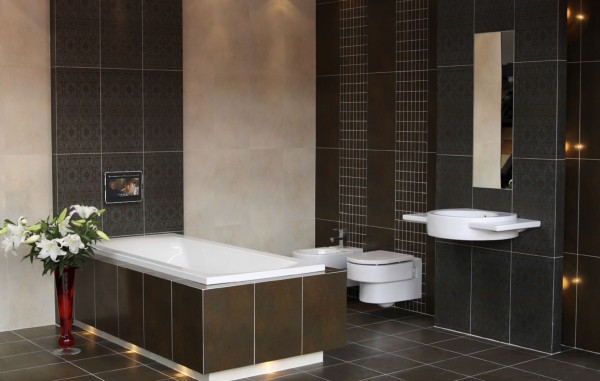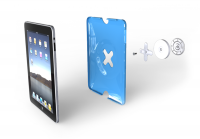The best products are often the simplest ones. The products that do their jobs with a minimum of fuss, that work as they’re supposed to without having to spend hours on the phone to tech support. But how do you go from the idea of a simple product to actually making it, selling it and then building a business around it? It’s a question that Melbourne entrepreneur Alon Tamir was faced with in his creation of the Wallee iPad wall mount.
Originally launching in July last year, the Wallee is a unique mounting bracket for the iPad that was designed to let you wall mount the 10-inch tablet anywhere in your house. It was born when Tamir felt the iPad got a bit uncomfortable to carry with extended use.
“I was travelling in New York at the time of the iPad 1 launch and managed to get a hold of one that week. Initially, media consumption was viewed as its primary value proposition, so early adopters were watching movies and TV via iTunes and YouTube. But the first iPad felt fairly heavy and uncomfortable to hold after about 5 minutes of use, and I saw the opportunity to enhance the product experience,” Tamir explains.
But getting from the idea of a wall mounting bracket to actually launching a product was a journey in itself for the Melbourne Computer Science graduate. A journey that began with coming up with a good design.
“From a functionality standpoint, It had to be intuitive to mount and dismount; it had to allow users to switch between portrait and landscape orientations while mounted; and the lock design needed to pave the way for an expandable system of modular accessories,” says Tamir, before adding, “Lastly, we were asking users to install something on their walls somewhat permanently, so the wall mount disk had to look good even without the iPad mounted.”
Those factors considered, Tamir created a few rough designs before engaging an engineer found on Google to tidy up the final design. From there, it took about two weeks to create the final design with an understanding that it would actually work. A few prototypes later, and Tamir could see for himself that the product not only worked, but worked well. Then came crunch time.
“Up until that point it was all conceptual and I had only ever seen the Wallee on a computer screen. The investment had been fairly low, but I needed to really bite the bullet and dive in so I took a flight to China and toured a few factories that specialised in injection moulding. After settling on one factory that I felt comfortable and confidant with I had them create the moulds and some test units (a 30 day process). I was back in China a month later to discuss and refine the mould, review the quality control processes they had in place and just made sure all was set for the initial volume run and there would be no nasty surprises.”
Taking the plunge to actually fly to China to source the production was only a small part of the challenge. Dealing with Chinese factories over email was quite manageable, according to Tamir, but in the flesh, dealing with engineers and technicians in the factories, it was significantly harder. “I had to get pretty creative the first time I went over while touring factories to get my ideas across, but it was a great experience overall. Now that I am dealing with more products and higher volumes I use an interpreter which makes it much easier,” Tamir admits.
With an initial run of 10,000 units, unit cost was kept to a minimum, while some positive press leading to a large numbers of pre-orders helped boost Tamir’s confidence that the product would succeed. Considering it was entirely self-funded from his job as an email marketer doing web design on the side, the success was well received. Within six months, the Wallee had global distribution, and customers began submitting suggestions for additional accessories, “I knew more accessories were part of the bigger picture, but didn’t realize how quickly the demand would present itself,” Tamir explains. But making accessories created its own problems.
“The decision to go bespoke with the accessories definitely took the challenge up a notch. Dealing with Aluminium is completely different to plastic, and I essentially had to learn an entirely new production process before scouting manufacturers in China. The design phase was in a way easier than it was for The Wallee, I already had the locking mechanism in place and it was designed to be easily added to any product I wanted to make. The challenge was getting the Aluminium finished to a degree of perfection very close to that of Apple products themselves. I was using the same materials and finishing processes, and really wanted that degree of quality, which I believe we did ultimately achieve, though there were extensive delays that we had to deal with in order to get to that point.”
Managing all aspects of the business originally kept Alon a very busy man. Working 18 hour days and “answering emails the other six from bed”, Tamir was not only dealing with the creation of the product, but also the marketing and maintaining the website, a job he has since contracted out.
Now approaching a year on from the original launch, Tamir has just launched his latest product, Pix and Stix, a set of iPad-friendly drumsticks and guitar pick for GarageBand on the iPad 2. Designing them took about two hours, and with a slightly different approach to funding, they were able to be announced in record time.
“I’ve been intrigued by sites like KickStarter.com in the US, and crowed funding in general, for a while and have always planned to give it a shot. Pix & Stix is the sort of product that I believed had the potential to go viral, which is really the key to this funding style. It’s also a real win-win for us and our fans, they get to be directly responsible for bringing a product to fruition and influence it from a very early stage, all with zero risk. For us, being able to tap into such a broad, global community of excited supporters is priceless.”
With a range of successful products under his belt, Tamir is getting ready to expand in order to maximise efficiency, especially in the distribution side of the business. There are no plans to develop products for non iOS products at the moment – no product offers the same “wow” factor in Tamir’s opinion.
But despite sticking with Apple’s ecosystem for his own products, Tamir is happy to offer his own suggestions to budding entrepreneurs out there.
“Do it! More specifically, don’t get caught up in the big lofty picture, just take the first step – no matter how small, then the next, and repeat,” Tamir tells us. Then he adds, “Also, reach out to people, most are more than happy to chat, and sometimes thats all it takes.”


